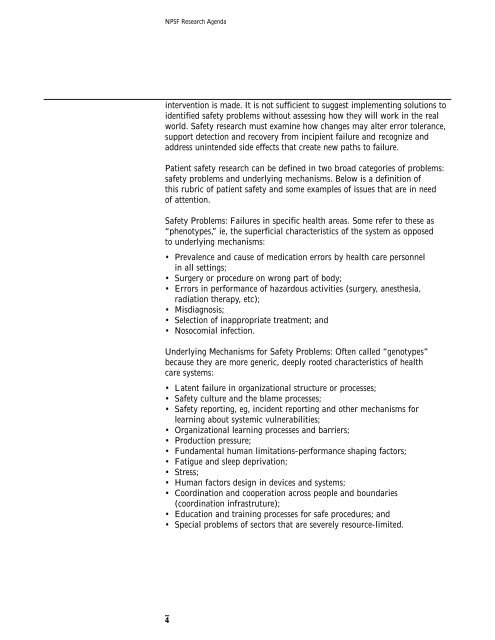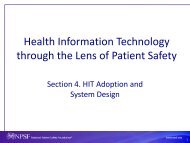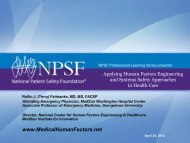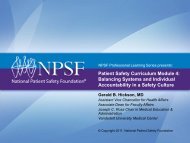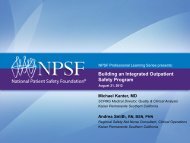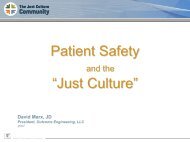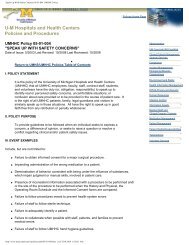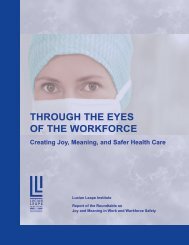Agenda for Research and Development in Patient Safety
Agenda for Research and Development in Patient Safety
Agenda for Research and Development in Patient Safety
- No tags were found...
You also want an ePaper? Increase the reach of your titles
YUMPU automatically turns print PDFs into web optimized ePapers that Google loves.
NPSF <strong>Research</strong> <strong>Agenda</strong><strong>in</strong>tervention is made. It is not sufficient to suggest implement<strong>in</strong>g solutions toidentified safety problems without assess<strong>in</strong>g how they will work <strong>in</strong> the realworld. <strong>Safety</strong> research must exam<strong>in</strong>e how changes may alter error tolerance,support detection <strong>and</strong> recovery from <strong>in</strong>cipient failure <strong>and</strong> recognize <strong>and</strong>address un<strong>in</strong>tended side effects that create new paths to failure.<strong>Patient</strong> safety research can be def<strong>in</strong>ed <strong>in</strong> two broad categories of problems:safety problems <strong>and</strong> underly<strong>in</strong>g mechanisms. Below is a def<strong>in</strong>ition ofthis rubric of patient safety <strong>and</strong> some examples of issues that are <strong>in</strong> needof attention.<strong>Safety</strong> Problems: Failures <strong>in</strong> specific health areas. Some refer to these as“phenotypes,” ie, the superficial characteristics of the system as opposedto underly<strong>in</strong>g mechanisms:• Prevalence <strong>and</strong> cause of medication errors by health care personnel<strong>in</strong> all sett<strong>in</strong>gs;• Surgery or procedure on wrong part of body;• Errors <strong>in</strong> per<strong>for</strong>mance of hazardous activities (surgery, anesthesia,radiation therapy, etc);• Misdiagnosis;• Selection of <strong>in</strong>appropriate treatment; <strong>and</strong>• Nosocomial <strong>in</strong>fection.Underly<strong>in</strong>g Mechanisms <strong>for</strong> <strong>Safety</strong> Problems: Often called “genotypes”because they are more generic, deeply rooted characteristics of healthcare systems:• Latent failure <strong>in</strong> organizational structure or processes;• <strong>Safety</strong> culture <strong>and</strong> the blame processes;• <strong>Safety</strong> report<strong>in</strong>g, eg, <strong>in</strong>cident report<strong>in</strong>g <strong>and</strong> other mechanisms <strong>for</strong>learn<strong>in</strong>g about systemic vulnerabilities;• Organizational learn<strong>in</strong>g processes <strong>and</strong> barriers;• Production pressure;• Fundamental human limitations-per<strong>for</strong>mance shap<strong>in</strong>g factors;• Fatigue <strong>and</strong> sleep deprivation;• Stress;• Human factors design <strong>in</strong> devices <strong>and</strong> systems;• Coord<strong>in</strong>ation <strong>and</strong> cooperation across people <strong>and</strong> boundaries(coord<strong>in</strong>ation <strong>in</strong>frastruture);• Education <strong>and</strong> tra<strong>in</strong><strong>in</strong>g processes <strong>for</strong> safe procedures; <strong>and</strong>• Special problems of sectors that are severely resource-limited.4


